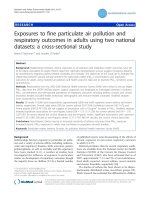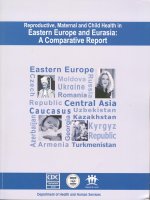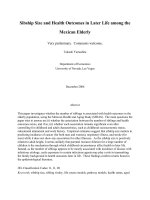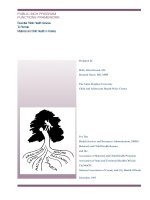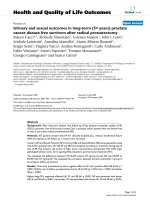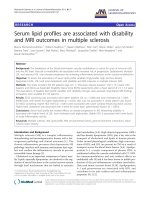Maternal and neonatal outcomes in pregnant women with autoimmune diseases in Pavia, Italy
Bạn đang xem bản rút gọn của tài liệu. Xem và tải ngay bản đầy đủ của tài liệu tại đây (439.45 KB, 6 trang )
Mazzucchelli et al. BMC Pediatrics (2015) 15:217
DOI 10.1186/s12887-015-0532-3
RESEARCH ARTICLE
Open Access
Maternal and neonatal outcomes in
pregnant women with autoimmune
diseases in Pavia, Italy
Iolanda Mazzucchelli1,2*† , Lidia Decembrino1†, Francesca Garofoli1, Giulia Ruffinazzi1, Véronique Ramoni3,
Mariaeva Romano3, Elena Prisco4, Elena Locatelli4, Chiara Cavagnoli4, Margherita Simonetta4, Annalisa De Silvestri5,
Piermichele Paolillo6, Arsenio Spinillo4 and Mauro Stronati1
Abstract
Background: The increased number of childbearing women with autoimmune diseases leads to a growing interest
in studying relationship among maternal disease, therapy, pregnancy and off-spring. The aim of this study was to
determine the impact of autoimmune disease on pregnancy and on neonatal outcome, taking into account the
maternal treatment and the transplacental autoantibodies passage.
Methods: We studied 70 infants born to 70 pregnant women with autoimmune disease attended in Fondazione
IRCCS Policlinico San Matteo, Pavia, Italy from June 2005 to June 2012. Maternal and neonatal characteristics were
collected and relevant clinical, laboratory, therapeutics, sonographic and electrocardiographic investigations were
recorded and analyzed.
Results: We observed a high rate of spontaneous abortions in medical history, 29 %, and 18.6 % of preterm births
and 22.9 % of low birth weight (< 2500 g). Transplacental autoantibodies passage wasn’t related to maternal or
obstetrical complication, but anti-Ro/SSA positive pregnancies correlated with abnormal fetal heart rate (P = 0.01).
Pregnant women on therapy showed an higher incidence of maternal (p = 0.002), obstetric (p = 0.007)
complications and an increased rate of intrauterine growth restriction (p = 0.01) than the untreated ones.
Conclusions: Autoimmune diseases in pregnancy require to be carefully monitored to ensure the best possible
management of mothers, fetuses and newborns due to the high rate of morbidity specially in case of maternal
polytherapy and/or anti-Ro/SSA positivity.
Keywords: Autoimmune disease, Pregnancy, Maternal and neonatal outcome
Background
Autoimmune diseases are a group of heterogeneous disorders characterized by the attack of the immune system
against its own cells, tissue or organs. In this context the
resultant autoinflammatory reaction could be antibodies
mediated or cytokines/protein mediated, with consequently multiple clinical and laboratory aspects [1]. Diseases are more frequent in female gender than in male
* Correspondence:
†
Equal contributors
1
Neonatal Unit and Neonatal Intensive Care Unit, IRCCS San Matteo Hospital
Foundation, Pavia, Italy
2
Department of Internal Medicine and Therapeutics, University of Pavia,
Pavia, Italy
Full list of author information is available at the end of the article
(78 %) and they could become critical during pregnancy
when the immune system is actively involved to tolerate
a successful gestation process [2, 3]. A pregnant woman
with an autoimmune disease, should be considered high
risk because of the modulation of inflammatory process,
the possible effects of therapy on the fetus and the transplacental passage of autoantibodies [4, 5]. High frequency of gestational and perinatal complications such
as preeclampsia, stillbirth, spontaneous abortions (11–
24 %), preterm birth (13.9 %) and intrauterine growth
restrictions (IUGR) (2.3 %) have been reported [6, 7].
Immunoglobulin G isotype antibodies can freely cross
the placenta with a linear relationship between gestational age and placental transfer [5]. Literature data
© 2015 Mazzucchelli et al. Open Access This article is distributed under the terms of the Creative Commons Attribution 4.0
International License ( which permits unrestricted use, distribution, and
reproduction in any medium, provided you give appropriate credit to the original author(s) and the source, provide a link to
the Creative Commons license, and indicate if changes were made. The Creative Commons Public Domain Dedication waiver
( applies to the data made available in this article, unless otherwise stated.
Mazzucchelli et al. BMC Pediatrics (2015) 15:217
report that anti-Ro/SSA and anti-La/SSB antibodies are
associated with neonatal lupus erythematosus and other
associated abnormalities such as congenital heart block
(CHB), cardiomyopathy, cutaneous lupus lesions, hepatobiliary disease, and hematologic cytopenias [8, 9]. Furthermore, an important issue concerns the use of drugs
to control maternal symptoms and exacerbations: these
substances and their metabolites can cross the placental
barrier and enter into the fetal circulation; this could influence the pregnancy progression, the fetus state and
the perinatal outcomes [4].
The aim of this study was to expose our experience
about the impact of autoimmune diseases on pregnancy,
fetus and neonate outcome, taking into account the
transplacental autoantibodies passage and the maternal
therapy.
Methods
This retrospective study was performed at Fondazione
IRCCS Policlinico San Matteo, Pavia, Italy from June
2005 to June 2012 and data of 70 women with a diagnosed autoimmune disease and of their 70 babies were
collected and analyzed. The hospital, located in the
north of Italy, is characterized by clinical, teaching and
research mission. All the women gave written informed
consent and the data was collected in a database and analyzed as anonymous data for research purpose.
The study was approved by the Ethics Committee,
IRCCS Fondazione Policlinico San Matteo, Pavia, Italy.
All the enrolled women had a diagnosed autoimmune
diseases in our Division of Rheumatology according to
widely used criteria [10] and had a positive test for at
least one autoantibody. Exclusion criteria were: multiple
pregnancy, congenital infections, perinatal asphyxia,
chromosomal syndromes. Any abnormalities occurring
during pregnancy were registered as well as obstetrical
and maternal information. Blood tests to evaluate maternal autoantibodies were performed during pregnancy according to the clinical protocol used in our Department.
Neonatal gestational age, weight, length, head circumference, Apgar score and cord pH were collected at birth
and adjusted for gestational and chronological age. Maternal and neonatal antinuclear autoantibodies (ANA)
were tested by a standard indirect immunofluorescence
technique, while anti-extractable nuclear antigen antibodies (ENA) were evaluated by commercially available
ELISA kits. Cardiac and cerebral ultrasound scans were
performed in the neonate at birth, while electrocardiogram (ECG) testing was done within the first week of
life. Electrocardiographic parameters were evaluated
with particular attention to PR interval (nv <140 ms),
heart rate, QT interval corrected according to the
Bazett’s formula (QTc) (nv <440 ms): slightly extended if
Page 2 of 6
the value is in the range of 440–470 ms and frankly abnormal if > 470 ms.
Statistical analysis
The Shapiro–Wilk test was used to test univariate normality of quantitative variables. When these were normally distributed, results were expressed as mean values
and SD, otherwise median values and interquartile range
were used (IQR; 25–75th percentile). Data were analyzed
adequately by Student t test or Mann–Whitney and by
analysis of variance (ANOVA) or Kruskal-Wallis test if
more than two groups were involved. All tests were twosided. P values ≤ 0.05 were considered statistically significant. Association between quantitative variables was
evaluated by Spearman non parametric correlation.
Qualitative variables were described by counts and percentages and data were analyzed by Fisher’s exact test.
Data analysis was performed using STATA statistical
package (version 12; Stata Corporation, College Station,
2011, Texas, USA).
Results
Characteristics of the enrolled women are reported in
Table 1. Obstetrical history of 70 women revealed an incidence of 29 % of miscarriages (40 out of 136
pregnancies).
Maternal complications observed among the 70 enrolled pregnant women were observed in 13 patients
Table 1 Characteristics of pregnant women
Mothers, number
70
Age, mean (SD)
33.3 years (5.1)
Pregnancy, number (%)
Term delivery (≥37 weeks)
57 (81.4)
Preterm delivery (<37 weeks)
13 (18.6)
Mode of delivery, number (%)
Vaginal delivery
33 (47.1)
Caesarean section
37 (52.9)
Autoimmune diagnosed disease, number (%):
Sjögren’s syndrome (SS)
Systemic lupus erithematosus (SLE)
9 (12.9)
Rheumatoid arthritis (RA)
3 (4.3)
Antiphospholipid syndrome (PAPS)
5 (7.1)
Undifferentiated connective tissue disease (UCTD)
19 (27.1)
Othersa
8 (11.4)
Not clinical manifest diseaseb
18 (25.7)
Drug therapy during pregnancy, number (%)
a
8 (11.4)
37 (52.9)
n = 1 autoimmune thyroiditis, n = 4 thrombocytopenia, n = 1 thyroiditis and
autoimmune gastritis, n = 1 ulcerative colitis, n = 1 Wegener’s granulomatosis.
All were ANA positive
b
Women positive to autoantibodies without clinical features of
autoimmune disease
Mazzucchelli et al. BMC Pediatrics (2015) 15:217
Page 3 of 6
(19 %): 2 cases of gestational diabetes, 5 of hypertension,
1 of massive pulmonary embolism, 1 of hypertransaminasemia and hyperbilirubinemia, 1 of anemia and furthermore, 1 autoimmune uveitis, 1 onset of Systemic
lupus erithematosus (SLE), 1 intrahepatic cholestasis due
to the worsening of the autoimmune disease.
Obstetric complications observed among the 70 enrolled pregnant women were observed in 29 cases
(41.4 %): abnormal fetal heart rate n = 7 (10 %), meconium stained amniotic fluid n = 8 (10.7 %), oligohydramnios n = 3 (4.3 %), polyhydramnios n = 2 (2.9 %), threat
of preterm delivery n = 3 (4.3 %), IUGR n = 4 (5,71 %),
positive indirect Coombs test n = 2 (2.9 %).
Neonatal characteristics are reported in Table 2.
All the newborns were tested for maternal autoantibodies at birth to assess the transplacental passage
(Table 3) and we didn’t observe significant differences
comparing data obtained from infants positive to maternal autoantibodies (46 out of 70) vs those that were
negative (18 out of 70). No differences in obstetric and
perinatal complications (Table 4), mode of delivery, gestational age, anthropometric parameters at birth and laboratory data, except for total bilirubin levels (7.2 vs
9.8 mg/dL, p = 0.05) were observed between infants positive to maternal autoantibodies and those negative. In
regard to the tested electrocardiographic values, no
Table 2 Characteristics of infants enrolled in the study
Gestational age, mean (SD)
38 weeks (3)
Sex, number (%)
Male
35 (50.0)
Female
35 (50.0)
Apgar score at 1′ and 5′, mean (SD)
9.0 (1.5) and 9.7 (0.9)
Cord pH, mean (SD)
7.27 (0.10)
Blood parameters,
Table 3 Autoantibodies detected in mothers and in the
newborns at birth
Autoantibodies Mothers (n = 70) Infants (n = 70) Placental transfer (%)
ANA
63
46
73
anti-SSA/Ro
22
22
100
anti-SSB/La
6
6
100
Othersa
3
0
0
a
other autoantibodies
differences were found in the two groups. We observed
that Ro/SSA and La/SSB autoantibodies crossed the placental barrier in 100 % of cases (Table 3) and five out
seven neonates with abnormal fetal heart rate were born
to mothers positive for anti-Ro/SSA (p = 0.01), of these
five neonates one was born to mothers treated with
hydroxychloroquine, one to mother with steroid and
three to mothers without therapy. Moreover, the routine
analysis of neonatal laboratory parameters of infants
born to mothers positive to anti-Ro/SSA versus infants
born to negative ones, didn’t show any statistically difference. We noted higher hemoglobin (p = 0.007), higher
hematocrit (p = 0.02) and higher total bilirubin levels (p
= 0.008) in the off-spring of negative mothers to antiRo/SSA, all these values were however in normal ranges.
Moreover, maternal and neonatal ANA titre were
highly correlated as evaluated by the Spearman rho 0.74,
p < 0.001.
Thirty-seven (52.0 %) pregnant women received medical therapy, they were treated with one or more drugs
for their autoimmune disease: 23 received steroid therapy (prednisone), 9 received hydroxychloroquine, 17 received low dose aspirin and 7 low molecular weight
heparin. Statistical analysis showed a higher incidence of
obstetrical (p = 0.007) and maternal (p = 0.002) complications in treated women than in non-treated ones, related to a higher incidence of preterm delivery (p = 0.06)
White Blood Cells x103/μl, mean (± SD)
15.3 (5.9)
Neutrophils x103/μl, mean (± SD)
8.6 (4.5)
Hemoglobin g/dL, mean (± SD)
17.2 (2.0)
Hematocrit, %
51.6 (6.5)
Table 4 Obstetric and perinatal events compared to
autoantibodies transplacental transfer
Platelets x103/μl, mean (± SD)
270.9 (75.5)
Obstetrical/perinatal events
3045 gr (699)
Abnormal fetal heart rate
14 (20.0)
Meconium stained amniotic fluid
5
3
NS
VLBW number (%)
1 (1.4)
Oligohydramnios
1
2
NS
ELBWc number (%)
1 (1.4)
Polyhydramnios
2
0
NS
Length, mean (SD)
49 cm (3.5)
Threat of preterm delivery
1
2
NS
Head circumference, mean (SD)
34 cm (2.4)
IUGR
3
1
NS
4 (5.7)
Positive indirect Coombs test
2
0
NS
Anthropometric data,
Weight at birth, mean (SD)
a
LBW number (%)
b
d
IUGR , number (%)
a
Low Body Weight (Birth weight < 2500 g)
Very Low Body Weight (Birth weight < 1500 g)
Extremely Low Body Weight (Birth weight < 1000 g)
d
IUGR Intrauterine growth restriction
Autoantibodies placental transfer
Yes (n = 46)
No (n = 18)
P-value
6
1
NS
Ventricular septal defect
1
0
NS
Cerebral alteration
4
4
NS
b
c
NS Not-Significant
Mazzucchelli et al. BMC Pediatrics (2015) 15:217
with low birth anthropometric parameters: weight (p =
0.003), length (p = 0.01) and head circumference (p =
0.004). In women undergoing both immunosuppressive
and anti-coagulant/anti-platelet therapy a significant
correlation with a higher incidence of IUGR newborns
compared to untreated women (p = 0.01) was registered.
Echocardiography revealed one case of ventricular septal defect in a IUGR preterm neonate.
Cerebral ultrasound scans revealed in 8 newborns the
following significant alterations: periventricular hyperechogenicity (n = 6), intraventricular hemorrhage which
resulted in pseudocysts or in multicystic leukomalacia
(n = 4), white matter leukodystrophy associated with
agenesis of the corpus callosum (n = 2). The statistical
analysis showed that these cases correlate significantly
with mother’s drug therapy, p = 0.005, but no correlation
was observed with the presence of anti-Ro/SSA, p = 0.4.
Discussion
Our observations, in agreement with data reported by
other authors, confirmed a higher frequency of miscarriages, of premature births and of low birth weight infants born to women with autoimmune disease
compared to epidemiologic data of general obstetric
population in developed countries [11]. Moreover, we
confirmed previous literature data showing that the
placental barrier is crossed by antibodies: more than
70 % of ANA and 100 % of anti-Ro/SSA and anti-La/
SSB [12, 13].
The association of anti-Ro/SSA maternal positivity
with neonatal lupus complicated by the congenital sinus
bradycardia, first degree AV block or elongated QTc has
been reported [14]. Our findings, instead, did not reveal
any neonatal lupus disease in the off-spring from positive mothers. Nevertheless, a statistically significant correlation between anti-Ro/SSA positive pregnancies and
abnormal fetal heart rate at the tococardiographic tracing was detected (p = 0.01). The arrhythmogenic role of
anti-Ro/SSA and anti-La/SSB was established in animal
and in human [13, 15] this effect could promote CHB in
newborns of mothers Ro/SSA and/or La/SSA positive.
We therefore supposed that the CHB has possibly been
prevented by an adequate and carefully monitored
pharmacological treatment during pregnancy. In our
study, in fact, 73 % of the mothers anti-Ro/SSA positive
received a pharmacological treatment to control their
autoimmune disease.
To date, even if there is no full agreement about the
effects of immunosuppressive drugs on pregnancy and
on fetus/infant, high-dose of immunosuppressive treatment administered to transplanted pregnant women has
been associated with a transient impairment of the immune system of the newborn, increasing the risk of neonatal infections in the first months of life [16]. Other
Page 4 of 6
authors carried out a study to evaluate relevant effects in
newborns and children born to women receiving immunosuppressants for their autoimmune disorders. No relevant effect on neonatal immune function, as evaluated
by complete blood count with differential white blood
cell count, immunoglobulin concentrations, lymphocyte
subpopulations, and later in response to hepatitis B vaccination were revealed [17]. In our study, as well, neither
neutropenia nor difference between white blood cells
and neutrophils count were reported in infants born to
treated women, compared to those born to untreated
mothers.
Furthermore, our findings revealed a statistical significant higher incidence of obstetric and maternal complication in treated women compared to those untreated.
Previously, an increased risk of preterm delivery, low
birth weight and IUGR associated with immunosuppressant therapy was reported by other authors [18].
We observed significantly lower values of neonatal anthropometric parameters at birth (weight, height and
head circumference) in the infants born to treated
mothers compared to untreated ones. Nevertheless we
have to remark that these infants had an earlier gestational age at birth too, which may be the reason of the
lower anthropometric measures. Interestingly, a higher
number of IUGR newborns (p = 0.01) was observed in
the group of women receiving polytherapy than in the
group of the untreated women. Unfortunately, we aren’t
able to conclusively address the correlation of this event
either with the polytherapy or with the worsening disease, requiring itself a more important therapy to control increasing symptoms. In fact both the conditions
coexist and are strictly linked.
Finally, the ultrasound evaluation showed cerebral alterations in 8 infants born to treated mothers, but these
alterations didn’t correlate to the mother’s positivity to
anti-Ro/SSA. Because the use of the drugs may be an indirect sign of the disease, it is unclear if the alterations
may be related to drug therapy, to the autoimmune disease or the results of the add up of these factors. These
data comply with the observations of Motta et al. [19]
that suggested no specific perinatal risk factor, but a
multi-factorial aetiology of brain abnormalities observed
in infants born to mothers with autoimmune disease.
A recent published review highlighted that the principal immunomodulant/immunosuppressive drugs administered during pregnancy have been shown to be
relatively safe, but the results are not conclusive [20].
Moreover, controlled clinical trials in pregnancy are not
ethical, therefore monitoring the pregnancy of these patients is the only available tool to have safety assessment.
In agreement with the cited authors we also hope that
international registries of the potential drug side effects
or of any useful information related to the pregnancy
Mazzucchelli et al. BMC Pediatrics (2015) 15:217
and the outcome of the off-spring will become common
and easily accessible over different countries [21]. Furthermore, it must be considered that autoimmune diseases could be undiagnosed before pregnancy because
the mild clinical illness that could be modified by the occurring pregnancy that interferes with the immune system. The administration of a screening questionnaire in
the first trimester of gestation has shown to be a useful
tool to identify in advance these subjects that could be
monitored carefully and, if necessary, managed the appropriate therapy to proceed successfully with the pregnancy [22].
We have therefore to take care of this dichotomous aspect: monitoring and balancing the necessity to identify
and treat maternal disease and to preserve fetal health.
In fact, it is important to protect mother and fetus from
the hazard of increasing symptoms without, on the other
hand, compromising the newborn well-being with possible drug side effects.
We are aware of the limits of our study. The sample
size didn’t allow to create subgroups related to different
autoimmune diseases. Furthermore, we could not state if
the findings were related to maternal disease or to drugs
therapy or to others causative factors, such as genetic
features or neonatal independent circumstance (prematurity), because some of these conditions are very often
concomitant. Finally, we had not the opportunity to follow the infants’ growth, therefore we have no information about the possible sequelae afterward in childhood.
Conclusion
The take home message of this investigation is that pregnancy of mothers suffering for an autoimmune disease
has to be carefully monitored. Placental transfer of maternal autoantibodies, and the possible effects of maternal therapy on the fetus/neonate are risk factors that
require a careful multidisciplinary management (gynecologists, rheumatologists and neonatologists) to ensure
the best possible maternal and neonatal outcome International registries describing the pattern of pregnancy
and the outcome of the off-spring could be an useful
tool to ameliorate the management of the mother/infant
dyad.
Abbreviations
ANA: Antinuclear autoantibodies; CHB: Congenital heart block;
ECG: Electrocardiogram; ENA: Anti-extractable nuclear antigen antibodies;
IQR: Interquartile range; IUGR: Intrauterine growth restrictions; SLE: Systemic
lupus erithematosus.
Competing interests
The authors declare that they have no competing interests.
Authors’ contributions
IM coordinated the study and data collection, wrote and submitted the
manuscript. LD coordinated the study, took care of the neonates, wrote and
submitted the manuscript. FG managed literature data, critically discussed
Page 5 of 6
the manuscript draft and revisited the final version of the manuscript. GR
took care of the neonates, collect patients’ consent and approved the final
version of the manuscript. VR took care of autoimmune disease in pregnant
women, registered data and approved the final version of the manuscript.
MR took care of autoimmune disease in pregnant women, registered data
and approved the final version of the manuscript. EP took care of
autoimmune disease in pregnant women, registered data and approved the
final version of the manuscript. EL took care of pregnancy of studied
women, registered data and approved the final version of the manuscript.
CC took care of pregnancy of studied women, registered data and approved
the final version of the manuscript. MS took care of pregnancy of studied
women, registered their data and approved the final version of the
manuscript. AdS made the statistical analysis, contributed to data
interpretation and approved the final version of the manuscript. PP
contributed to the conception of the study, interpretation of data and
approved the final version of the manuscript. AS contributed to the
conception of the study, interpretation of data and approved the final
version of the manuscript. MS contributed to the conception of the study,
interpretation of data and critically revisited the manuscript.
Acknowledgments
The authors thank Micol Angelini and Claudia Cova, Neonatal and Neonatal
Intensive Care Unit, Fondazione IRCCS Policlinico San Matteo, Pavia, Italy, for
their precious support to organize the database.
Author details
1
Neonatal Unit and Neonatal Intensive Care Unit, IRCCS San Matteo Hospital
Foundation, Pavia, Italy. 2Department of Internal Medicine and Therapeutics,
University of Pavia, Pavia, Italy. 3Division of Rheumatology, IRCCS San Matteo
Hospital Foundation, University of Pavia, Pavia, Italy. 4Department of
Obstetrics and Gynecology, IRCCS San Matteo Hospital Foundation,
University of Pavia, Pavia, Italy. 5Biometry Unit, San Matteo Hospital
Foundation, P.le Golgi 19, Pavia 27100, Italy. 6Division of Neonatology and
Neonatal Intensive Care, Casilino General Hospital, Roma, Italy.
Received: 21 July 2015 Accepted: 9 December 2015
References
1. Wahren-Herlenius M, Dörner T. Immunopathogenic mechanisms of systemic
autoimmune disease. Lancet. 2013;382:819–31.
2. Cooper GS, Stroehla BC. The epidemiology of autoimmune diseases.
Autoimmun Rev. 2003;2:119–25.
3. Ngo ST, Stein FJ, McCombe PA. Gender differences in autoimmune disease.
Front Neuroendocrinol. 2014;35:347–69.
4. Østensen M, Khamashta M, Lockshin M, Parke A, Brucato A, Carp H, et al.
Anti-inflammatory and immunosuppressive drugs and reproduction.
Arthritis Res Ther. 2006;8:209–28.
5. Palmeira P, Quinello C, Silveira-Lessa AL, Zago CA, Carneiro-Sampaio MC.
IgG placental transfer in healthy and pathological pregnancies. Clin Dev
Immunol. 2012; doi:10.1155/2012/985646.
6. Brucato A, Cimaz R, Caporali R, Ramoni V, Buyon J. Pregnancy outcomes in
patients with autoimmune diseases and anti-Ro/SSA antibodies. Clin Rev
Allergy Immunol. 2011;40:27–41.
7. Lin HC, Chen SF, Lin HC, Chen YH. Increased risk of adverse pregnancy
outcomes in women with rheumatoid arthritis: a nationwide populationbased study. Ann Rheum Dis. 2010;69:715–7.
8. Hon KL, Leung AKC. Neonatal Lupus Erythematosus. Autoimmune Dis.
2012; doi:10.1155/2012/301274.
9. Lee LA. Transient autoimmunity related to maternal autoantibodies:
neonatal lupus. Autoimmun Rev. 2005;4:207–13.
10. Bykerk VP, Massarotti EM. The new ACR/EULAR classification criteria for RA:
how are the new criteria performing in the clinic? Rheumatology.
2012;5:vi16–20.
11. Kramer MS, Zhang X, Platt RW. Analyzing risks of adverse pregnancy
outcomes. Am J Epidemiol. 2014;179:361–7.
12. Jaeggi E, Laskin C, Hamilton R, Kingdom J, Silverman E. The Importance of
the Level of Maternal Anti-Ro/SSA Antibodies as a Prognostic Marker of the
Development of Cardiac Neonatal Lupus Erythematosus. A Prospective
Study of 186 Antibody-Exposed Fetuses and Infants. J Am Coll Cardiol.
2010;55:2778–84.
Mazzucchelli et al. BMC Pediatrics (2015) 15:217
Page 6 of 6
13. Salomonsson S, Sonesson SE, Ottosson L, Muhallab S, Olsson T,
Sunnerhagen M, et al. Ro/SSA autoantibodies directly bind cardiomyocytes,
disturb calcium homeostasis, and mediate congenital heart block. J Exp
Med. 2005;201:11–7.
14. Ambrosi A, Salomonsson S, Eliasson H, Zeffer E, Skog A, Dzikaite V, et al.
Development of heart block in children of SSA/SSB-autoantibody-positive
women is associated with maternal age and displays a season-of-birth
pattern. Ann Rheum Dis. 2012;71:334–40.
15. Strandberg L, Salomonsson S, Bremme K, Sonesson SE, Wahren-Herlenius M.
Ro52, Ro60 and La IgG autoantibody levels and Ro52 IgG subclass profiles
longitudinally throughout pregnancy in congenital heart block risk
pregnancies. Lupus. 2006;15:346–53.
16. Fuchs KM, Coustan DR. Immunosuppressant therapy in pregnant organ
transplant recipients. Semin Perinatol. 2007;31:363–71.
17. Cimaz R, Meregalli E, Biggioggero M, Borghi O, Tincani A, Motta M, et al.
Alterations in the immune system of children from mothers treated with
immunosuppressive agents during pregnancy. Toxicol Lett.
2004;149:155–62.
18. Tincani A, Rebaioli CB, Frassi M, Taglietti M, Gorla R, Cavazzana I, et al.
Pregnancy and autoimmnunity: maternal treatment and maternal disease
influence on pregnancy outcome. Autoimmun Rev. 2005;4:423–8.
19. Motta M, Zambelloni C, Rodriguez-Perez C, Angeli A, Lojacono A, Tincani A,
et al. Cerebral ultrasound abnormalities in infants born to mothers with
autoimmune disease. Arch Dis Child Fetal Neonatal Ed. 2011;96:F355–8.
20. Gerosa M, Meroni PL, Cimaz R. Safety considerations when prescribing
immunosuppression medication to pregnant women. Expert Opin Drug Saf.
2014;5:1–9.
21. Mekinian A, Lachassinne E, Nicaise-Roland P, Carbillon L, Motta M, Vicaut E,
et al. European registry of babies born to mothers with antiphospholipid
syndrome. Ann Rheum Dis. 2013;72:217–22.
22. Spinillo A, Beneventi F, Ramoni V, Caporali R, Locatelli E, Simonetta M, et al.
Prevalence and significance of previously undiagnosed rheumatic diseases
in pregnancy. Ann Rheum Dis. 2012;71:918–23.
Submit your next manuscript to BioMed Central
and we will help you at every step:
• We accept pre-submission inquiries
• Our selector tool helps you to find the most relevant journal
• We provide round the clock customer support
• Convenient online submission
• Thorough peer review
• Inclusion in PubMed and all major indexing services
• Maximum visibility for your research
Submit your manuscript at
www.biomedcentral.com/submit


